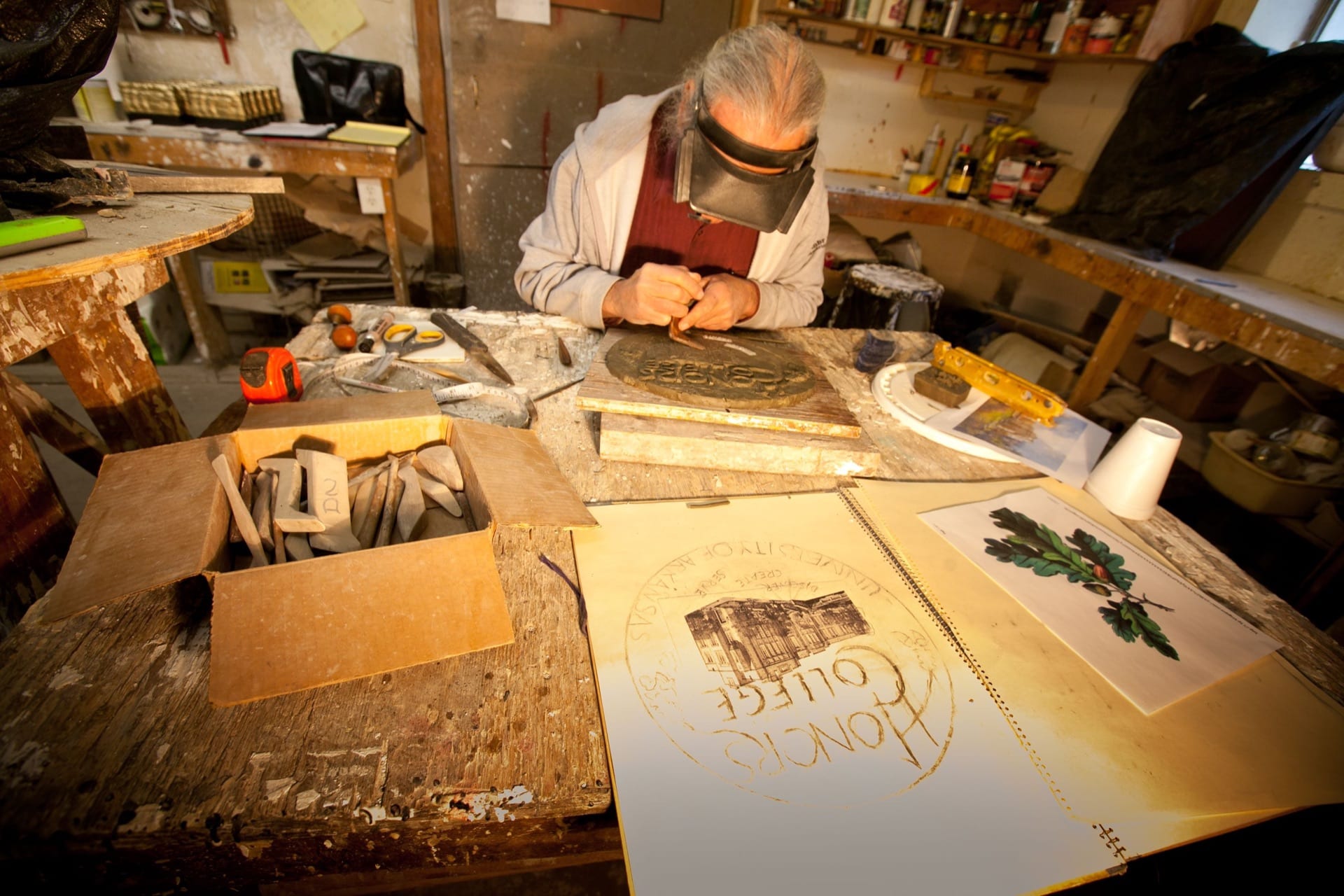Sculptor Hank Kaminsky leans forward and peers through a magnifying visor pulled over his gray ponytail. His 6’3” frame hunches over a clay disk 12” in diameter – a new medal in the making. The words “Honors College” curve across the top in a flourish of Celtic-inspired script, while the outlines of the new addition to Ozark Hall – future home of the Honors College – are roughed in below. Kaminsky, himself a proud honors alumnus of the University of Arkansas, has been laboring on the clay model for more than a month.
The lettering looks more or less complete, but he emphasizes that he’s spent many more hours on the building that’s barely begun to emerge from the picture plane.
“The lettering’s in my head, and the building is not,” he explains. “There are a lot of decisions to be made. How far should I go in rendering little bits of architectural detail? The building is complex, and I’ve got to simplify it so that it still reads and it’s interesting.”
Hank Kaminsky has been commissioned to create a new Honors College medal that will be awarded to outstanding faculty, alumni and staff. A smaller version of the medal will also be available to honors programs across campus to recognize students graduating with Latin honors. The ten professors who received Honors College Distinguished Faculty and Distinguished Leadership Awards last fall will be the first to receive the finished medal, in time to add it to their commencement regalia in May.
The design process began with a series of meetings with the medal committee, which included honors faculty, a student, and staff. Discussions about the history, role and mission of the Honors College prompted a broad range of design ideas; the group eventually reached consensus on a bold, simple scheme emphasizing the Honors College name, new home and “mantra” – the words “Discover,” “Create” and “Serve.”
“It’s an opportunity to address the tradition – but I love to experiment with form,” Kaminsky said. The design innovations appear in subtle details, such as the way certain letters curve into oak leaves (a reference to the oak leaves in the University of Arkansas seal) and the depth of the building, which may require that the medal be struck, reheated, and struck again to ensure that all details emerge.
Originally from New York state, Hank Kaminsky began his studies in electrical engineering but switched majors to art after a friend gave him some clay. He subsequently studied at the Art Students League, the Pennsylvania Academy of the Fine Arts and the New School before earning his bachelor’s degree in art with high honors at the University of Arkansas in 1985. [Editor’s note: Latin distinctions – cum laude, magna cum laude and summa cum laude – were introduced at a later date.] He studied medal making under Walker Hancock, designer of the original Olympic medal, and credits Italian Renaissance sculptors such as Pisanello, Ghiberti and Donatello as inspiration for the painstaking process of making a major statement in miniature.
“It’s a sculpture of 10,000 touches,” Kaminsky said. “You just have to keep putting clay in places where it seems to belong; it’s a very fluid process.” Pointing to traces of lines around the emerging form of Ozark Hall, he adds: “The shape of this building has changed maybe ten times.”
When asked what has been most rewarding about the process, Kaminsky flashes a grin and says, “It ain’t here yet. That comes when I get the thing in my hand. The lead proof never fails to thrill me.”
Hold a Kaminsky medal in your hand, and you too will be hooked. The finely carved details invite study, while the solid heft of six ounces of bronze embodies the achievement that the medal represents. We will share photographs of the medal when it is completed.
Our thanks to the medal committee members, who played a key role in inspiring Hank Kaminsky’s design. They are honors program directors Claretha Hughes (College of Education and Health Professions), Javier Reyes (Samuel M. Walton College of Business), Curt Rom (Dale Bumpers College of Agricultural, Food and Life Sciences) and Kim Sexton (Fay Jones College of Architecture); honors physics and English major Ameé J. Salois (J. William Fulbright College of Arts and Sciences) and director of communications Kendall Curlee (Honors College).

